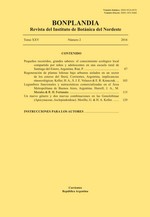Regeneration of woody plants under isolated shrubs in a sector of the Iberá marshlands, Corrientes Province, Argentina, ethnoecological implications.
DOI:
https://doi.org/10.30972/bon.2521260Palavras-chave:
Ilex dumosa, incipient forest, ka’a mirĩ, nurse plants, woody succession, MarshlandResumo
A study of the natural regeneration of woody species under isolated bushes in a sector of northeast of Ibera Macrosystem is presented. The aim of the study was to evaluate the nurse effect of shrubs and structural parameters of regeneration. We show that the presence of isolated shrubs is fundamental to establish regeneration and that Ilex dumosa var. guaranina, Miconia chamissois, and Ocotea lancifolia promoted their abundance and richness. The regeneration involved 21 species, but was mainly structured by Miconia chamissois, Ilex dumosa var. guaranina, Citronella gongonha, and Myrsine parvula. The results indicate that Ilex dumosa var. guaranina was the most abundant solitary species and one of the best to regenerate under these conditions. While this shrub may constitute the initial stage in the formation of more or less large forests fragments, we suggest that the abundance of Ilex dumosa var. guaranina in this kind of primary woody succession prompted the expression “ka’a mirĩ” (the incipient forest), a guarani name of this species.Downloads
Não há dados estatísticos.
Downloads
Publicado
2016-07-01
Como Citar
Keller, H. A., Velazco, S. J. E., & Krauczuk, E. R. (2016). Regeneration of woody plants under isolated shrubs in a sector of the Iberá marshlands, Corrientes Province, Argentina, ethnoecological implications. Bonplandia, 25(2), 103–114. https://doi.org/10.30972/bon.2521260
Edição
Seção
Artículos originales
Licença
Declaration of Adhesion to Open Access
- All contents of Bonplandia journal are available online, open to all and for free, before they are printed.
Copyright Notice
- Bonplandia magazine allows authors to retain their copyright without restrictions.
- The journal is under a Creative Commons Attribution 4.0 International license.















.jpg)


